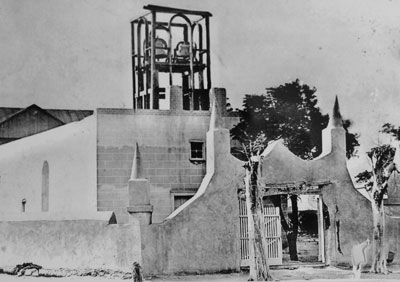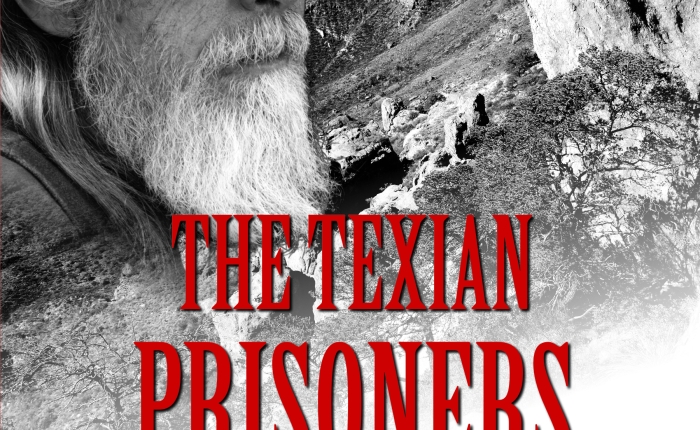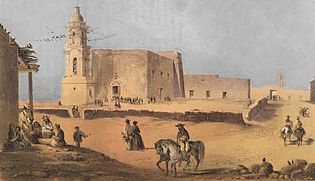Like what you see here? I also publish a newsletter (more or less monthly) with video links, dichos, short pieces about New Mexico history, and other Old New Mexico news. You can sign up here. I hope you’ll join me!
The Priest at El Paseo del Norte
this is a stand in for the Ramon Ortiz post. I need to establish the link.
The Priest at El Paso del Norte
When the men in my recent novel The Texian Prisoners reach El Paso del Norte (today’s Ciudad Juárez in November 1841, one of the kindest people they meet is local priest, Padre Ramón Ortiz. Prisoner George Wilkins Kendall, who later wrote a book about their trek, says Ortiz had a “benevolent countenance … that at once endeared him to every one.” The priest was also generous, “continually seeking opportunities to do some delicate act of kindness, which, by the manner of its bestowal, showed that he possessed all the more refined feelings of our nature.”
The padre housed, clothed, and gave money to Kendall and other men of the Texas Santa Fe Expedition while they were in El Paso. And his generosity didn’t stop there. When the prisoners headed out on the next leg of their journey, he sent along two or three ox-carts filled with “excellent bread.”
“Seldom have I parted from a friend with more real regret,” Kendall said later. “If ever a noble heart beat in man it was in the breast of this young, generous, and liberal priest. Professing a different religion from mine, and one, too, that I had been taught to believe, at least in Mexico, inculcated a jealous intolerance towards those of any other faith, I [thought I] could expect from him neither favour nor regard. How surprised was I, then, to find him liberal to a fault, constant in his attentions, and striving to make my situation as agreeable as the circumstances would admit.”
One would be tempted to conclude from Kendall’s description that Ramon Ortiz was sympathetic toward the Texians and, by extension, Americans. After all, most of the prisoners had been born in the United States. And the padre may well have felt that way in 1841. But he seems to have changed his mind by the end of the decade.
Padre Ortiz opposed America’s 1846 invasion of Mexico so vociferously that U.S. soldiers arrested him when they reached El Paso. Incarceration doesn’t seem to have curbed his spirit. He continued to voice his opposition and, as a deputy to Mexico’s Congress, fought ratification of its 1848 treaty with the U.S.
Ortiz was concerned about the amount of land the treaty of Guadalupe Hidalgo proposed to give away, which included today’s California, Arizona, Utah, and New Mexico. But he didn’t give up when he lost that cause. After the treaty was signed, he took on another role: helping New Mexico families who wished to move south across the new border, and thus remain Mexican citizens.
In late 1848, Mexico sent Padre Ortiz north into New Mexico to identify these people and assist them in the transition. His mission was so successful that the new regime in Santa Fe shut it down.
Ortiz arrived in the Santa Fe area in April 1849 and soon had approximately 1,000 families signed up for the trek south. And those were just the ones from San Miguel del Bado. When he then headed north toward Taos, the American administration panicked and started actively discouraging people from leaving while also throwing up bureaucratic obstacles related to signatures, funding, deadlines, and so forth.

Even with these roadblocks, by mid-1850, the padre had successfully assisted 1,552 people to leave their homes in the new American possessions and move across the border to the Mesilla area. He then took on a new role and served as the commissioner responsible for issuing land grants to the new settlers.
If you’re familiar with New Mexico, you’ll know Mesilla is a town in the southern part of the state, on the U.S. side of the border. No, it didn’t move. The land on which the padre settled the newcomers was sold to the Americans in late December 1853. While the emigrants were adjusting to their new location, the U.S. had arranged to pay Mexico another $10 million for a strip of land that would enable a railroad route from Texas to California. Land that included Mesilla.
I haven’t found a record of Padre Ortiz’s response to that exchange of real estate. I doubt he was pleased. But he had plenty of time to adjust to what had happened. He was priest at El Paso del Norte for another forty-two years.
If Kendall’s portrayal of him is accurate, it’s possible that Padre Ortiz, unlike so many of us, was able to distinguish between individuals and the country they came from and continued to be as full of “exceeding liberality” as he’d been in 1841. I don’t think I could have done so.
If you want to learn more about Mesilla’s fascinating history, see https://www.mesillanm.gov/history/ or Erlinda Gonzales-Berry and David R. Maciel’s, The Contested Homeland, A Chicano History of New Mexico. You can find a short review of this book in this month’s newsletter. Sign up here!
Source List: Erlinda Gonzales-Berry and David R. Maciel, The Contested Homeland, A Chicano History of New Mexico, University of New Mexico Press, 2000; George Wilkins Kendall, Narrative of the Texan Santa Fe Expedition, Harper and Brothers, 1847; W.H. Timmons, El Paso, A Borderlands History, Texas Western Press, 2004
The Call of the Cranes
I haven’t seen any sandhill cranes in the Santa Fe area yet this year, but recently I ran across a section of Lt. James W Abert’s 1846-47 New Mexico travel diary which definitely evoked them:
Tuesday, October 13: [outside Bernalillo] “… we are now surrounded by cranes that keep up a great whooping all night. Their cry bears some resemblance to that of the red[headed] woodpecker.” The following day, the roadside ponds near Alameda “were covered with cranes, geese, and ducks. All these birds are quite tame and suffered us to approach very close (Abert, 44).”
Not close enough to be killed, though. In fact, whenever Abert or one of his companions appeared with a gun, the birds slipped out of range.
If you’ve had a chance to read The Texian Prisoners, you’ll notice that the men under Damasio Salazar also encounter sandhill cranes, first at Pecos Pueblo and then later along the Rio Grande. The birds, grazing in the stubble of harvested corn and wheat, stay well out of reach. When a horseman canters across the fields, they and the snow geese with them rise in great waves, their cries filling the air.
I have responded viscerally to the call of the cranes since I first heard it here in New Mexico. Abert’s observation that the sound resembled that of the redheaded woodpecker prompted more research. While the woodpecker’s actual call doesn’t seem to have much similarity to the sandhill’s, the sound of its drumming actually does.
Listen for yourself: Here’s the woodpecker drumming (at :31) and here’s the sandhill crane (choose the Garrett McDonald one). Isn’t the similarity amazing?
There’s an important difference to my ear though. The woodpecker is boring a hole in something. The cranes are talking, calling across the sky as they fly overhead through the long shadows of a New Mexico sunset.
How the Texian prisoners must have envied their freedom.
Note: the attached crane images were taken by me at two of my favorite birding places in New Mexico, the Bernardo Waterfowl Area of the Ladd S. Gordon complex south of Belen and the Bosque del Apache National Wildlife Refuge.
New Year, New Book!
I’m pleased to announce that my novel The Texian Prisoners will be published in March next year and that the ebook is now available for pre-order!
In Fall 1841, a band of roughly 300 Texans straggled out of the Staked Plains into New Mexico. They had intended to claim everything east of the Rio Grande for Texas. Instead, they were captured and sent south to El Paso del Norte, then on to Mexico City. The largest group of prisoners, which included journalist George Wilkins Kendall, was escorted to El Paso by Captain Damasio Salazar. Five prisoners died on that trek. Kendall would later write a book describing the experience, a book which accused Salazar of food deprivation, mutilation, and murder, and fed the glowing coals that would become the Mexican-American War.
But what really happened on the way to El Paso? The Texian Prisoners tells the story through the eyes of Kendall’s friend George Van Ness, a lawyer burdened with the ability to see his enemy’s point of view, and asks us to consider the possibility that Kendall’s report was not unbiased.
A historically accurate retelling of Larry McMurtry’s Dead Man’s Walk, this fictional memoir will make you question everything you thought you knew about Texas, New Mexico, and the boundary between them.
Available for pre-order from Amazon.com and other ebook retailers.
BOOK REVIEW: Letters and Notes on the Texan Santa Fe Expedition, 1841-1842
In June this year, I posted something very rare for me: a less-than-positive book review. The review was of a book that serves as a primary source for most historical research about the ill-fated 1841 Texan Santa Fe Expedition. I had a number of issues with that text. However, during my own work on the Expedition, I was pleased to discover primary source that I can recommend wholeheartedly: Letters and Notes on the Texan Santa Fe Expedition, 1841-1842 by Thomas Falconer.
Falconer was one of the few British members of the Expedition. A trained barrister with a strong interest in the natural sciences, he traveled to Texas to explore emigrating there and was almost immediately invited by President Lamar to accompany the Expedition as a scientific observer.
Kendall describes Falconer as a “gentleman of high literary and scientific attainments [with] mild and agreeable manners,” who was “extremely sociable and companionable” (Kendall, I, 26-27), rather careless of his appearance, but well equipped with “a number of books and scientific instruments” (Kendall, I, 43).
Falconer’s books, instruments, and notes were, unfortunately, confiscated when the Texans finally reached New Mexico. However, his memory and interest in his surroundings stood him in good stead. After he was released from prison in Mexico City, he went to New Orleans, where he developed a report for Kendall’s newspaper, the New Orleans Picayune. This and his “Notes of a Journey Through Texas and New Mexico,” published in the British Journal of the Royal Geographical Society in 1844, form the core of Letters and Notes.
This book is valuable for several reasons. First, it provides an antidote to Kendall’s more excitable, and not altogether trustworthy, version of events in New Mexico in 1841; second, it gives us valuable information about the geography and plants of the region during the early 1840s; and third, it provides an outsider’s view of the Texans and their foibles, as well as insight into the sort of information about the North American continent that the English found useful.
Falconer’s other books, one about the Oregon question, and another about the discovery of the Mississippi, are also fascinating reads, but if you’re interested in the history of New Mexico, particularly the 1841 Texan Santa Fe Expedition, I highly recommend his Letters and Notes.
Sources: Thomas Falconer, Letters and Notes on the Texan Santa Fe Expedition, 1841-1842, New York: Dauber and Pine, 1930; George Wilkins Kendall, A Narrative of the Texan Santa Fe Expedition, Vol. II, Harper and Brothers: New York, 1847.
Texan Prisoners Reach El Paso!
When the last of the men from the Texas Santa Fe Expedition reached El Paso del Norte (today’s Juarez) in early November 1841, they must have felt as if they’d come out of hell into paradise.
They had traveled roughly 1000 miles from Austin, Texas to New Mexico, starving a good deal of the way, then about 500 more, as prisoners, from eastern New Mexico to the Rio Grande, then south, a route that included the desert-like Jornada del Muerto, or Journey of the Dead Man. They had endured unbearable heat on the plains and snow and icy winds on the Jornada. Now, though they were still prisoners, life had become much easier.
The very weather had changed. George Wilkins Kendall noticed it the night before they arrived, when, he says, “the evening air was of a most wooing temperature mild and bland” (Kendall, II, 23). As the Texans reached the outskirts of El Paso, they saw that the very plant life was different. The valley, irrigated by a canal from the Rio Grande, boasted abundant wheat, onions up to four pounds in weight, fruit trees, and extensive vineyards (Timmons, 195).
Even Kendall, who spent almost all his time in Mexico complaining, liked El Paso del Norte. Although his report doesn’t mention its famous building, the mission of Guadalupe de los Mansos, he does rhapsodize about the city’s “delightful situation in a quiet and secluded valley, its rippling artificial brooks, its shady streets, its teeming and luxurious vineyards, its dry, pure air and mild climate, and, above all, its kind and hospitable inhabitants” (Kendall, II, 42).

Source: es.wikipedia.org/wiki/Misión_de_Guadalupe_de_los_Mansos_en_el_Paso_del_río_del_Norte Accessed 10/17/23
Part of the reason Kendall was so impressed by the hospitality was that he was one of several Texans hosted by Presidio Commander José María Elías González. And hosted lavishly. Kendall reports the afternoon hot chocolate, the evening wine in glasses the size of New England tumblers, the tasty blood puddings, and other details of the table with great glee.
But the party couldn’t go on forever. The Texan prisoners were on the road again on Tuesday, November 9, heading to Chihuahua en route to Mexico City, where life would again become difficult. The idyll of El Paso was over, and prison and the whims of President Santa Anna, who the Texans had humiliated at San Jacinto, waited ahead.
Partial Sources: Ruben Cobos, A Dictionary of New Mexico & Southern Colorado Spanish, Santa Fe: Museum of New Mexico Press; George Wilkins Kendall, A Narrative of the Texan Santa Fe Expedition, Vol. II, Harper and Brothers: New York, 1847; W.H. Timmons, El Paso, A Borderlands History, El Paso: Texas Western Press, 2004.
Damasio Salazar on the Assignment From Hell
Mexican militia captain Damasio Salazar hadn’t been particularly pleased about his assignment to take the final batch of Santa Fe Texas Expedition prisoners south to El Paso del Norte. However, the past four days hadn’t been too bad. The prisoners had complained, of course, and he’d had a bit of trouble locating enough food for them, but the communities between San Miguel del Bado and Valencia had been surprisingly generous, especially the pueblos north of Albuquerque.
But now, on Monday, October 21, 1841, trouble had really started. First, he woke to a dead prisoner. Felix Ernest had been weak to begin with. And no wonder. He’d been with the Texans who had been out the longest and starved the most. The poor scurvy-ridden devils had ended up eating lizards, snakes, and boiled horse hide. Ernest hadn’t been actually ill, as far as Salazar knew. He was just too weak to wake up.
The Captain acted quickly to prevent other prisoners from dying on him by immediately requisitioning a cart from the Valencia alcalde and loading the weakest men onto it. But the dilapidated thing was so overwhelmed with riders that it fell apart a mile down the road.
This disaster precipitated another problem. A Texan who’d been riding, a man named McAllister, was so lame he couldn’t walk any further. When one of the more stupid of Salazar’s guards threatened to shoot him, the Texan yelled at him to do just that, and the idiot took him at his word.
Now Salazar had two dead prisoners to account for when he reached El Paso. He couldn’t very well carry the bodies with him. He’d had to resort to cutting off the men’s ears as proof they hadn’t run away.
He must have been thankful when he and his column finally reached the day’s destination, a grove of cottonwoods on the east bank of the Rio Grande south of Belen. The captain ordered one of the nineteen Texan cattle slaughtered. Maybe the meat would put some strength into the men and get them through what was to come. There were only a few more towns where he could acquire rations. Then, he and his prisoners would face the Jornada del Muerto.
By his calculations, they would be crossing right at the end of October. He needed to get 187 men, their guards, and the animals across a 90 mile stretch of wasteland notorious for a lack of water, especially this time of year. It was at least a three-day journey across a land of sand, rocky outcroppings, and an occasional stunted cactus. There was a reason it was called the journey at death.
The place lived up to its name. Three more men died crossing the Jornada. Salazar took their ears as well, and presented them to the Presidio commandant at El Paso del Norte. Although the Texan prisoners, particularly American newsman George Kendall, were appalled by what they saw as his savagery, the Captain was actually following orders —and precedent. The use of ears to account for dead enemies had been instituted by the man he presented them to in early November 1841.
Salazar did face a court-martial however, in response to questions Kendall raised about the Texan cattle left grazing outside El Paso. Once he’d been cleared of wrongdoing, the Captain returned to New Mexico. He would live out his days there, although he did have a brush with Anglo retribution in December 1846, when he was accused of participating in a conspiracy against American occupation.
There was no evidence that he’d been involved in those aborted plans and Salazar was allowed to go home in peace. Whether or not he was still haunted by the memories of the 1841 march south to El Paso is another question entirely.
Book Review: When Cimarron Meant Wild
David Caffey’s recent book When Cimarron Meant Wild fills an important gap in the historiography of northeast New Mexico, specifically Colfax County, a.k.a. Cimarron Country. There are a number of books available about different aspects of the county and the personalities that made it legendary in its time, but up to this point, none of them have tied everything together, as Caffey’s does.
The County is inextricably linked to what became known as the Lucien B. Maxwell Land Grant. But When Cimarron Meant Wild begins long before the grant was established in the 1840s and reminds us that the land was home to indigenous populations well prior to either Spanish or American occupation.
Caffey also explains how these peoples—the Jicarilla Apache and Moache Ute—continued to play a role in the area well into the mid-19th century. Most of the material about Colfax County I’ve seen up to this point has very little to say about the original peoples, their rights to the land, and how they were gradually pushed off of it. I was impressed with the way When Cimarron Meant Wild addresses this issue.
The book also does an excellent job of describing Lucien Maxwell’s rather relaxed approach to exploiting the area’s resources, both agricultural and mineral. The difference between his strategy and that of the British corporation he and his wife sold out to in 1870 is an excellent study in contrasts. The Corporation was intent on wringing every penny out of their new possession, previous arrangements be damned. This shift in attitude created the environment that erupted into what became known as the Colfax County War, a conflict Caffey estimates resulted in 52 deaths over the next 11 years.
When Cimarron Meant Wild builds on Caffey’s previous work on New Mexico’s Santa Fe Ring and details the way the British corporation worked with Ring members, most notably Thomas B. Catron and Thomas Elkins, to eliminate the small-holders and miners who they felt were blocking the way to greater profits. The violence that resulted is documented here in detail but never sinks to a mere record of facts. Quite the opposite. The book’s organization and narrative flow is so masterful that it reads like a novel.
When Cimarron Meant Wild contains the best description I have yet read of the Colfax County War. Caffey not only provides an excellent retelling of both small and large events, he also gives us snapshots of the personalities involved without sentimentality or condemnation something I as a fiction writer find especially compelling.
This book is readable, historically accurate, and fills in important gaps for those of us who know a little about the area and want to learn more. If you aren’t familiar with northeast New Mexico’s or the Maxwell Land Grant’s fascinating history, When Cimarron Meant Wild is definitely the place to start learning about it. I highly recommend this book!
BOOK REVIEW: FATHER STANLEY
Instead of doing a typical book review this time, I’ve chosen to write about one of my favorite New Mexico authors, the man who wrote under the pseudonym Fr. Stanley. Born in New York in 1908, Stanley Louis Crocchiola was ordained at age 30 in the Franciscan Order of Atonement. He had contracted tuberculosis by this time, so his superiors sent him to Hereford, Texas where they assumed the arid climate would help him heal. Ironically, he arrived there in February 1939 during a black dust storm. He survived that, though, and in 1940 was transferred to Santa Fe, New Mexico. The dry climate does seem to have suited him. He lived to be 87.
He used that time to learn about the history of the various communities he served in New Mexico and, in 1948, began chronicling their history. The resulting books, published under the pseudonym Fr. Stanley, are a charming mixture of stories told by old-timers, newspaper clippings, and on-the-ground observations. Many of them are printed on folded-over 8.5 x 11 paper stapled in the cross-section, or saddle-stitched, a kind of historical chapbook.
Fr. Stanley’s books often have the same simple cover design–a bright yellow background containing a red zia symbol and typeface. At least for the New Mexico books, the titles are also often nearly identical. The four I own are The Stanley (New Mexico) Story, The Elizabethtown (New Mexico) Story, The San Miguel del Bado (New Mexico) Story, and The Miami (New Mexico) Story.
Father Stanley wrote and published over 170 books, the majority in this simple format, though some, like The Duke City: The Story of Albuquerque, New Mexico and The Civil War in New Mexico were published in hardback. They are all a great resource for discovering the details of New Mexican life in the late 19th and early 20th centuries–everything from the types of apples grown in Miami to the names of the men on the Elizabethtown baseball team.
This interest in the minutiae of life is the defining characteristic of Father Stanley’s books and makes them well worth reading because they give us an almost newspaper-like glimpse into a bygone world. The only trouble is, they’re no longer currently being published. If you want a copy of The Bethel (New Mexico) Story, The Texico (New Mexico) Story, The Causey (New Mexico) Story, The Grant That Maxwell Bought, The Magdalena (New Mexico) Story, The Abo (New Mexico) Story, The Golden (New Mexico) Story, or any of the others, you’re going to have to find a secondhand bookseller.
I encourage you to do so, even at the risk of driving up prices on the many Stanley books that I still don’t have in my collection. For sheer joy in New Mexico history, in all its details, I recommend Father Stanley’s work!













